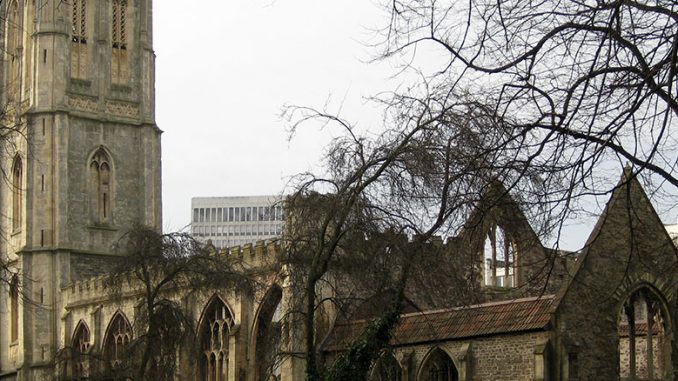
Knights Templar architecture is shown in this image of Temple Church Bristol by NotFromUtrecht – Own work, CC BY-SA 3.0
by Alan Butler
Within a very short period of the formation of the Poor Knights of Christ and the Temple of Solomon, a new style of church architecture began to spread across Western Europe. The first examples of this are to be seen in France, where great Cathedrals such as that of Chartres sing loud the praise of what became known, much later as ‘Gothic’. Whether or not the Knights Templar had any direct part in the creation of this revolution in religious building has always been something of a bone of contention, though it is clear that the fledgling organisation had learned very early in its history, the value of good, sound architectural practice.
It would be rather strange in an organisation specifically dedicated to holding territory against prolonged attack, such as in the Holy Land, should fail to address the requirements of castle building. There was no mystery about this art during the Middle Ages. The Templars did have a distinct advantage however. Being an international organization, it was able to draw on the building practices of the many different nation states that supplied its personnel. The Templars were able to use the very best techniques previously employed by English, French, German and Italian castle builders, supplemented by what they very quickly learned from both adversaries and friends in the Levant. Thus, they created massive structures, able to withstand heavy bombardment. It must be remembered however that these massive castles were nothing out of the ordinary for the period and, in terms of innovation, may prove to be less impressive than some of the finer and smaller buildings attributed to the Templar Order.
In addition, the Templars were very familiar with the massive citadels of Southern France and the ruins of those created in the Jordan Valley a millennium or more before their own era. This ability of the Templars, to look and learn, is often understated in the work or writers who seek to explain the extraordinary feats of the Knights Templar in other ways.
It is in the realms of domestic and Church architecture that the work of the Templar craftsmen can be seen at its best. The Templars built comparatively few castles, compared to the 9,000 or more Commanderies throughout Europe. Some of these were little more than substantial farms, where necessity and practicality dictated both the buildings themselves and the styles adopted. For example, being in the main farmers, the Templars learned quickly how to build massive barns, a few examples of which still survive. Timber framed, and incredibly beautiful, these buildings were first and foremost ‘functional’, a word that epitomises Templar endeavours at every level.
Although, as I have already suggested, the Templars have been linked with the origins of the Gothic style of architecture, they rarely if ever employed the same techniques themselves to any great extent. Gothic cathedrals are composed of ‘ogives’ the distinctive pointed, rounded arch that became popular again in Victorian times. In Gothic architecture, these are piled in arcades, one on top of another. The ogive is immensely strong, facilitating thinner walls than in earlier churches, thus allowing for larger windows. Stresses were passed outside of the building to the famous ‘flying buttresses’, that are a distinctive part of Cathedral design across Europe from the 12th century on. Both St Bernard of Clairvaux, as a leading light of the Cistercian Order, and the Templars have been linked with the rise of Gothic architecture, though there is no definitive proof of this.
The Templars themselves came to prefer circular, or octagonal churches, though this was far from being the case originally. Permission for the Templars to build their own churches was granted as early as 1139. The first examples are usually rectangular and definitely do not conform to the Gothic. On the contrary, these early Templar ecclesiastical buildings are ‘vaulted’, rather than arched. They were extremely strong (perhaps a response to architects familiar with fortified buildings) and usually had semicircular apses (maybe a response to Middle Eastern architecture of the same period.) Like their brothers, the Cistercians, the Templars sought functionality, rather than beauty. The general techniques involved in theses first structures show strong connections with none Templar architecture of the same period and particularly with Norman architecture within France and, especially, parts of Britain.
The round or octagonal churches came a little later. One of the best surviving examples of a Templar round church is to be found in London. (An article elsewhere in this edition deals specifically with the church in question.) Where it proved necessary, as in the London example, the expansion of a church might include a rectangular chancel and significant numbers of outbuildings, though in the main Templar churches remained ‘modest’, in comparison with the massive Cathedrals and abbeys springing up during the same period. In those areas where Templar personnel had been recently fighting in the Holy Land, it can be observed that their churches begin to look more like fortified manors, such as examples in Portugal and Spain, though even here the circular and rectangular examples predominate. It is likely that a preference for circular and octagonal churches sprang from a reverence for the very buildings the Templars were trying to protect in Jerusalem, such as the Church of the Holy Sepulchre.
It is important at every level in our research not to imbue the Knights Templar with superhuman qualities. There is nothing particularly unusual about any Templar building, when taken alongside similar buildings of the same period created by other agencies. What is noticeable is the polyglot approach to Knights Templar architecture, which might be expected of an organization with such international connections, and which travelled so extensively. However, quality seems to have been of paramount importance, together with functionality, a consideration that permeated practically every aspect of Templar achievement throughout the whole reign of the Order.
As wealth and influence grew, which was also the case with the Templars monastic brothers the Cistercians, so St Bernard of Clairvaux’s original instructions for ’simple architecture’, began to be forgotten. Later Templar buildings, and particularly the churches, are clearly more ornate. For example, originally, neither the Cistercians or the Templars allowed burials with effigies to invade the sacred space of churches. Later Templar churches, such as the London example, show how this cast iron rule was eventually forgotten, or circumnavigated, with rich patrons laid to rest within the church, often under elaborately carved canopies. In the main however it is observable that the Templars stuck to St Bernard’s observation much more than did the Cistercians, though this may be due to a proliferation of small Templar churches, as opposed to the fewer, but much grander Cistercian abbeys.
Knights Templar Architecture represented only one arm of the Templar empire. Of course it was important, particularly at the level of defence, so it is hardly surprising that we marvel at the sheer ‘bulk’ of Templar castles and citadels. However, it took many thousands of Commanderies, farms, granges and toll cottages to keep even a comparatively few castles in the Holy Land garrisoned and supplied. At the demise of the Templars many of their humbler architectural creations will have been either demolished, or incorporated into later structures. Had this not been the case, modern observers may find themselves overwhelmed by the sheer ‘number’ of Templar buildings across Europe and beyond, rather than by the architectural splendour of any specific example.
The Knights Templar were practical men living in an unforgiving world. They knew about the nuts and bolts of life better than any other organization of their time, and they responded accordingly. That so many of their Knights Templar architectural creations are still to be found (in the case of Churches many still in use) proves the soundness of their techniques and the durability of their craftsmanship. Perhaps we may find any number of geometric certainties or arcane mysteries embedded within the arrangement of specific Templar creations. However, to this writer at least the sheer scale of Templar building, in such a comparatively short period of time, and across so wide an area, proves to be the most breathtaking realisation.
Knights Templar Architecture.
About Us
We hope you enjoyed this archive article on Knights Templar Architecture.
TemplarHistory.com was started in the fall of 1997 by Stephen Dafoe, a Canadian author who has written several books on the Templars and related subjects.
Read more from our Templar History Archives – Templar History

